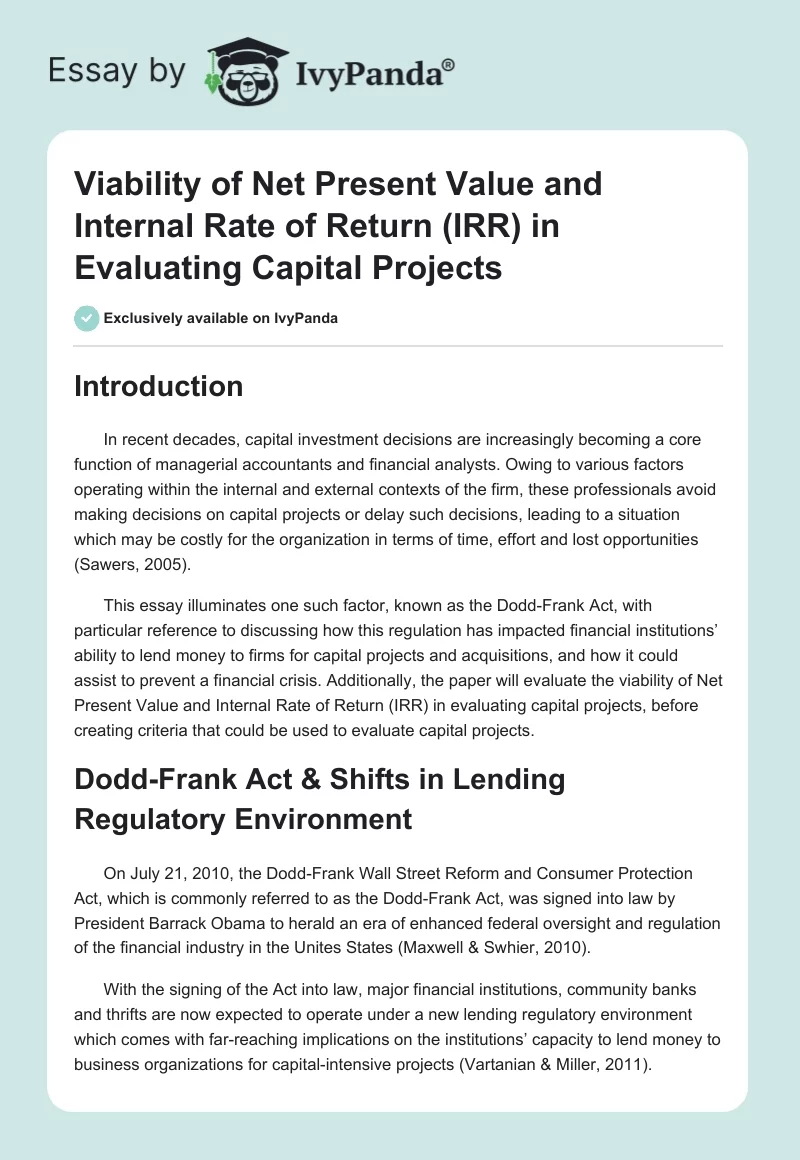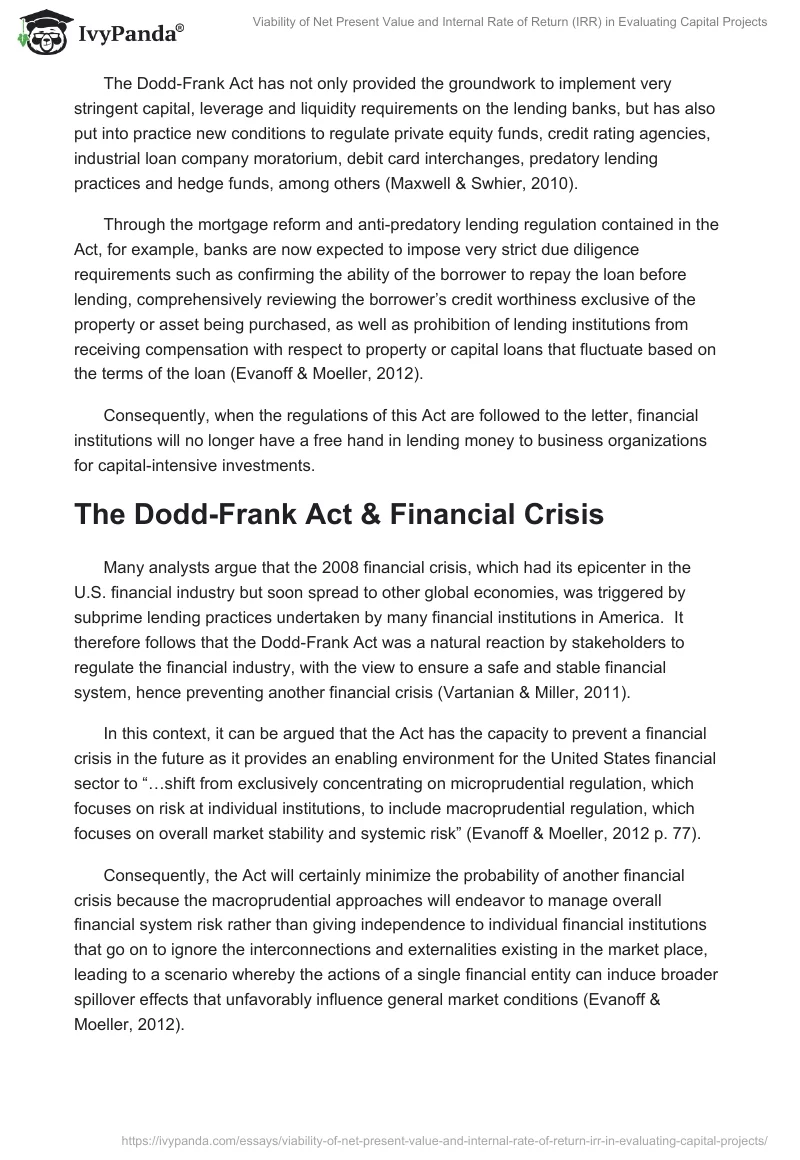Introduction
In recent decades, capital investment decisions are increasingly becoming a core function of managerial accountants and financial analysts. Owing to various factors operating within the internal and external contexts of the firm, these professionals avoid making decisions on capital projects or delay such decisions, leading to a situation which may be costly for the organization in terms of time, effort and lost opportunities (Sawers, 2005).
This essay illuminates one such factor, known as the Dodd-Frank Act, with particular reference to discussing how this regulation has impacted financial institutions’ ability to lend money to firms for capital projects and acquisitions, and how it could assist to prevent a financial crisis. Additionally, the paper will evaluate the viability of Net Present Value and Internal Rate of Return (IRR) in evaluating capital projects, before creating criteria that could be used to evaluate capital projects.
Dodd-Frank Act & Shifts in Lending Regulatory Environment
On July 21, 2010, the Dodd-Frank Wall Street Reform and Consumer Protection Act, which is commonly referred to as the Dodd-Frank Act, was signed into law by President Barrack Obama to herald an era of enhanced federal oversight and regulation of the financial industry in the Unites States (Maxwell & Swhier, 2010).
With the signing of the Act into law, major financial institutions, community banks and thrifts are now expected to operate under a new lending regulatory environment which comes with far-reaching implications on the institutions’ capacity to lend money to business organizations for capital-intensive projects (Vartanian & Miller, 2011).
The Dodd-Frank Act has not only provided the groundwork to implement very stringent capital, leverage and liquidity requirements on the lending banks, but has also put into practice new conditions to regulate private equity funds, credit rating agencies, industrial loan company moratorium, debit card interchanges, predatory lending practices and hedge funds, among others (Maxwell & Swhier, 2010).
Through the mortgage reform and anti-predatory lending regulation contained in the Act, for example, banks are now expected to impose very strict due diligence requirements such as confirming the ability of the borrower to repay the loan before lending, comprehensively reviewing the borrower’s credit worthiness exclusive of the property or asset being purchased, as well as prohibition of lending institutions from receiving compensation with respect to property or capital loans that fluctuate based on the terms of the loan (Evanoff & Moeller, 2012).
Consequently, when the regulations of this Act are followed to the letter, financial institutions will no longer have a free hand in lending money to business organizations for capital-intensive investments.
The Dodd-Frank Act & Financial Crisis
Many analysts argue that the 2008 financial crisis, which had its epicenter in the U.S. financial industry but soon spread to other global economies, was triggered by subprime lending practices undertaken by many financial institutions in America. It therefore follows that the Dodd-Frank Act was a natural reaction by stakeholders to regulate the financial industry, with the view to ensure a safe and stable financial system, hence preventing another financial crisis (Vartanian & Miller, 2011).
In this context, it can be argued that the Act has the capacity to prevent a financial crisis in the future as it provides an enabling environment for the United States financial sector to “…shift from exclusively concentrating on microprudential regulation, which focuses on risk at individual institutions, to include macroprudential regulation, which focuses on overall market stability and systemic risk” (Evanoff & Moeller, 2012 p. 77).
Consequently, the Act will certainly minimize the probability of another financial crisis because the macroprudential approaches will endeavor to manage overall financial system risk rather than giving independence to individual financial institutions that go on to ignore the interconnections and externalities existing in the market place, leading to a scenario whereby the actions of a single financial entity can induce broader spillover effects that unfavorably influence general market conditions (Evanoff & Moeller, 2012).
Net Present Value (NPU) and Internal Rate of Return (IRR)
Extant literature demonstrates that organizations should utilize discounted cash flow (DCF) methods, including internal rate of return (IRR) and net present value (NPV), to select and evaluate capital investment projects (Correia, 2012).
However, the NPV technique is often preferred by accounting managers and financial analysts when evaluating capital projects as it provides them with a leeway to deal with challenges emanating from the assessment “…of mutually exclusive alternatives, when the timing of the project cash flows differ or when the project represents a non-conventional project; that is, a project which has significant positive and negative cash flows over the life of the project” (Correia, 2012 p. 11).
Although a considerable number of stakeholders within the financial sector view the IRR to be a better approach, especially owing to its capacity to demonstrate the margin between the return of the project and the required return, the NPV approach turns out strongest in assessing capital-intensive projects due to its capability to incorporate the complete set of value drivers of the investment project (Bosch et al., 2007).
Criteria for Capital Investment Decision
There exist diverse criteria and approaches that management accountants and financial analysts can use to assess critical resource investment projects and make decisions on whether such projects should be accepted or rejected.
Upon evaluating a strand of existing literature on capital investment, it is generally felt that an ideal analytic process for evaluating the viability or acceptability of capital projects has five criteria, namely:
- active consideration of the number of alternative future business environments, including future eventualities of capital projects so as to practice decision making in a variety of environmental conditions,
- unambiguous consideration of the riskiness of a decision in both anticipated and unanticipated futures,
- clear specification, discussion and acceptability of diverse risk profiles,
- active consideration of the flexibility of system selected for assessment, and
- a dynamic demonstration, articulation, and rehearsal of existing contingency plans (Arms et al., 2012; Sawers, 2005).
Flexibility of the decision-making system as well as the active consideration of the number of alternatives available, are of fundamental importance in guiding the capital project’s acceptance or rejection process.
Conclusion
This paper has effectively illuminated issues in capital investment decisions, with particular reference to the effects of the Dodd-Frank Act, viability of NPV and IRR in evaluating capital projects, and the development of criteria that could be used to decide on whether to accept or reject a project undertaken in an environment of scarce resources.
From the discussion, it is clear that that the Dodd-Frank Act will forever affect the way banking institutions lend money to firms for capital projects, though the Act could not have come at a better time as it is poised to prevent the recurrence of another financial crisis.
References
Arms, H., Wiecher, M., & Weiderman, V. (2012). Dynamic models for managing big decisions. Strategy & Leadership, 40(5), 39-46.
Bosch, M.T., Montllor-Serrats, J., & Tarrazan, M.A. (2007). NPU as a function of the IRR: The value drivers of investment projects. Journal of Applied Finance, 17(2), 41-45.
Correia, C. (2012). Capital budgeting practices in South Africa: A Review. South African Journal of Business Management, 43(2), 11-29.
Evanoff, D.D., & Moeller, W.F. (2012). Dodd-Frank: Content, purpose, implementation status, and issues. Economic Perspectives, (3), 75-84.
Maxwell, T.M., & Swhier, C.V. (2010). Dodd-Frank Act significantly changes regulatory environment for community banks and thrifts. Bank Accounting & Finance, 23(6), 11-56.
Sawers, K.M. (2005). Evidence of choice avoidance in capital-investment judgments. Contemporary Accounting Research, 22(4), 1063-1092.
Vartanian, T.P., & Miller, G.L. (2011). Systemic regulation of large bank holding companies under the Dodd-Frank Act. Bank Accounting & Finance, 24(1), 3-11.


